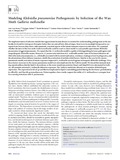Mostrar el registro sencillo del ítem
Modeling Klebsiella pneumoniae pathogenesis by infection of the wax moth Galleria mellonella
| dc.creator | Insua, José Luis | es_ES |
| dc.creator | Llobet, Enrique | es_ES |
| dc.creator | Moranta, David | es_ES |
| dc.creator | Pérez Gutiérrez, Camino | es_ES |
| dc.creator | Tomás, Anna | es_ES |
| dc.creator | Garmendia García, Juncal | es_ES |
| dc.creator | Bengoechea Alonso, José Antonio | es_ES |
| dc.date.accessioned | 2019-01-23T11:16:17Z | |
| dc.date.available | 2019-01-23T11:16:17Z | |
| dc.date.issued | 2013 | |
| dc.identifier.issn | 0019-9567 (Print) | |
| dc.identifier.issn | 1098-5522 (Electronic) | |
| dc.identifier.uri | https://hdl.handle.net/2454/32076 | |
| dc.description.abstract | The implementation of infection models that approximate human disease is essential for understanding pathogenesis at the molecular level and for testing new therapies before they are entered into clinical stages. Insects are increasingly being used as surrogate hosts because they share, with mammals, essential aspects of the innate immune response to infections. We examined whether the larva of the wax moth Galleria mellonella could be used as a host model to conceptually approximate Klebsiella pneumoniae-triggered pneumonia. We report that the G. mellonella model is capable of distinguishing between pathogenic and nonpathogenic Klebsiella strains. Moreover, K. pneumoniae infection of G. mellonella models some of the known features of Klebsiella-induced pneumonia, i.e., cell death associated with bacterial replication, avoidance of phagocytosis by phagocytes, and the attenuation of host defense responses, chiefly the production of antimicrobial factors. Similar to the case for the mouse pneumonia model, activation of innate responses improved G. mellonella survival against subsequent Klebsiella challenge. Virulence factors necessary in the mouse pneumonia model were also implicated in the Galleria model. We found that mutants lacking capsule polysaccharide, lipid A decorations, or the outer membrane proteins OmpA and OmpK36 were attenuated in Galleria. All mutants activated G. mellonella defensive responses. The Galleria model also allowed us to monitor Klebsiella gene expression. The expression levels of cps and the loci implicated in lipid A remodeling peaked during the first hours postinfection, in a PhoPQ- and PmrAB-governed process. Taken together, these results support the utility of G. mellonella as a surrogate host for assessing infections with K. pneumoniae. | en |
| dc.description.sponsorship | Fellowship support to J.L.I. from the Conselleria d'Educació, Cultura i Universitats Govern Illes Balears (cofunded by the European Regional Development Fund) is gratefully acknowledged. Part of this work was supported by grants from the Biomedicine Program of the Ministerio de Economía y Competitividad (grants SAF2009-07885 and SAF2012-39841) to J.A.B. The Laboratory of Microbial Pathogenesis is supported by a grant to competitive groups (project reference 46/2011) from the Conselleria d'Educació, Cultura i Universitats Govern Illes Balears (cofunded by the European Regional Development Fund). CIBERES is an initiative from the Instituto de Salud Carlos III. | en |
| dc.format.extent | 14 p. | |
| dc.format.mimetype | application/pdf | en |
| dc.language.iso | eng | en |
| dc.publisher | American Society for Microbiology | en |
| dc.relation.ispartof | Infection and immunity, october 2013, vol. 81, nº 10, p. 3552–3565 | en |
| dc.rights | © 2013, American Society for Microbiology. All Rights Reserved. | en |
| dc.subject | Infection | en |
| dc.subject | Galleria mellonella | en |
| dc.title | Modeling Klebsiella pneumoniae pathogenesis by infection of the wax moth Galleria mellonella | en |
| dc.type | info:eu-repo/semantics/article | en |
| dc.type | Artículo / Artikulua | es |
| dc.contributor.department | IdAB. Instituto de Agrobiotecnología / Agrobioteknologiako Institutua | es |
| dc.rights.accessRights | info:eu-repo/semantics/openAccess | en |
| dc.rights.accessRights | Acceso abierto / Sarbide irekia | es |
| dc.identifier.doi | 10.1128/iai.00391-13 | |
| dc.relation.publisherversion | https://doi.org/10.1128/iai.00391-13 | |
| dc.type.version | info:eu-repo/semantics/publishedVersion | en |
| dc.type.version | Versión publicada / Argitaratu den bertsioa | es |


